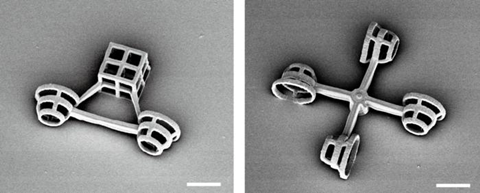Researchers have created tiny, vehiclelike structures which can be maneuvered by microscopic algae. The algae are caught in baskets attached to the micromachines, which have been carefully designed to allow them enough room to continue swimming.

Two types of vehicles were created in the study, published in Small: the “rotator,” which spins like a wheel, and the “scooter,” which was intended to move in a forward direction but in tests moved more surprisingly. The team is planning to try different and more complex designs for their next vehicles. In the future, these mini algae teams could be applied to assist with micro-level environmental engineering and research.
Swift swimmer
“We were inspired to try and harness Chlamydomonas reinhardtii, a very common algae found all over the world, after being impressed by its swift and unrestricted swimming capabilities,” said Naoto Shimizu, a student from the Graduate School of Information Science and Technology at the University of Tokyo (at the time of the study), who initiated the project. “We’ve now shown that these algae can be trapped without impairing their mobility, offering a new option for propelling micromachines which could be used for engineering or research purposes.”

The micromachines were created using a 3D printing technology called two-photon stereolithography. This printer uses light to create microstructures from plastic. The team worked at a scale of 1 micrometer, equal to 0.001 millimeter. According to the researchers, the most challenging part was optimizing the design of the basket-shaped trap, so that it could effectively capture and hold the algae when they swam into it.
The traps were attached to two different micromachines. The first, called the scooter, has two traps which hold an alga in each and looks a bit like a podracer from Star Wars. The second, called the rotator, has four traps holding in total four algae and is similar to a Ferris wheel. The size and shape of the baskets allowed the alga’s two flagella (small, whiplike appendages) to continue moving, propelling the machines along.
Machine movements
“As we had hoped, the rotator displayed a smooth rotational movement. However, we were surprised by the scooter. We thought it would move in one direction, as the algae face the same way. Instead, we observed a range of erratic rolling and flipping motions,” explained lead author Project Research Associate Haruka Oda, also from the Graduate School of Information Science and Technology (IST). “This has prompted us to further investigate how the collective movement of multiple algae influences the motion of the micromachine.”
According to the researchers, the main advantage of these micromachines over those driven by different organisms, is that neither the machine nor the algae require any chemical modification. The algae also do not need external structures to guide them into the trap. This enables greater freedom of movement for the micromachine, as well as simplifying the process.
Mini-chariots
We don’t yet know how long these micro-chariots and their tiny steeds can survive and continue to function. Individual Chlamydomonas reinhardtii can live for about two days, multiplying to produce four new algae. The experiments were carried out over several hours, during which the micromachines maintained their form.
Next, the team wants to enhance the rotator to spin faster and create new, more complex machine designs.
“The methods developed here are not only useful for visualizing the individual movements of algae, but also for developing a tool that can analyze their coordinated movements under constrained conditions,” said Professor Shoji Takeuchi from IST, who supervised the project.
“These methods have the potential to evolve in the future into a technology that can be used for environmental monitoring in aquatic environments, and for substance transport using microorganisms, such as moving pollutants or nutrients in water.”







No comments yet